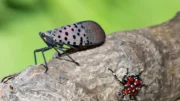The appeal remains the same as ever.
From the days of Pirates – and probably even before that – to now, treasure hunting is a thrilling hobby. Finding the X on a map that represents prizes and glory is a thrill, just as it ever was.
Of course, you need not carry a broadsword and sport an eye patch to be a seeker these days.
A GPS unit will do just fine, thank you.
With one of those, you can participate in geocaching, a worldwide sport where people alternately hide and find “treasures” left by others.
It works like this: someone hides a “cache,” or container of some kind, above ground. It might be a can, plastic box, fake rock or even plastic fruit. Whatever the container, inside are little treasures, be they tokens, trinkets, marbles, action figures, toy cars, toy soldiers, coins, a logbook, or something else.
Each cache is identified with a set of GPS coordinates – relating to latitude and longitude — and, in cases, a clue as to where they’re located. Some are fairly obvious and easy to get to; others are more difficult on terms of how well they’re hidden and how hard it is to reach them.
In all cases, geocachers seek out the hidden objects, as if on a scavenger hunt, taking a trinket from the box and as often as not leaving a different one behind.
A handheld GPS unit is the real key to playing this game, though some also use an app on their smartphone. Most units will pinpoint to within a half dozen feet or less any cache. A map used in conjunction with the unit helps figure out how to get to that spot from where you are.
Then, it’s a matter of searching.
Some caches are hidden in hollow logs, for example. Some are tucked under foot bridges. All are – according to the “rules” or etiquette of the game – supposed to be unobtrusive, inconspicuous enough not to be noticed by casual passers-by but not hidden in a way that harms surrounding vegetation or terrain.
Meaning, it’s not supposed to be buried.
Still, finding one can be trickier than you’d imagine the first time you’re out. It gets a little easier with experience, as you develop a knack for thinking like the person who did the hiding.
Then, that often becomes part of the game. People who start out seeking caches ending up hiding one or two of their own.
It’s another way to add to their fun.
Finding caches – or rather, finding the coordinates for caches – can be done in multiple ways. The easiest perhaps is registering at geocaching.com. It maintains a list of more than three million geocaches in 191 countries across all seven continents.
There are geocaching clubs all around the country, too.
Then, with an “arrrgh” and “Aye, matey” it’s time to go looking.
Whether you’re first love is, say, hiking and geocaching is a way to tweak that, or geocaching itself is the main attraction, chances are you’ll have fun.
Bob Frye is the Everybody Adventures editor. Reach him at (412) 216-0193 or bfrye@535mediallc.com. See other stories, blogs, videos and more at EverybodyAdventures.com.








































